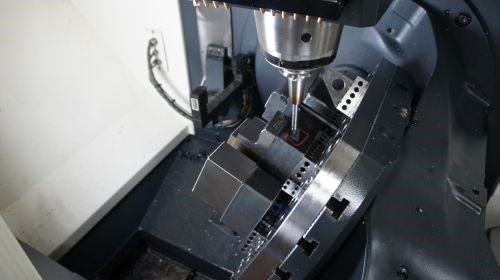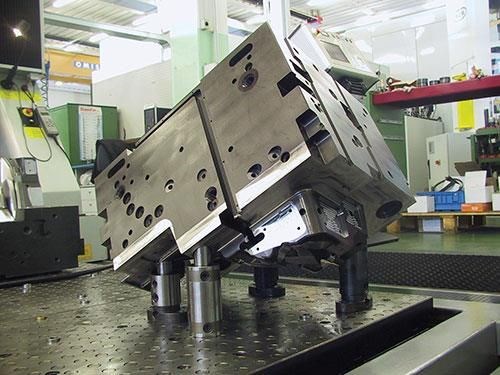Five-Axis Demands a Talented Supporting Cast
This mold manufacturer’s choice of workholding, programming and cutting tool technology helped maximize the time available to navigate the challenges of getting used to its first-ever five-axis machining center.
Share






Legacy Precision Molds recognized early on that its first-ever five-axis machine, a DMU 50 from DMG MORI, would present a significant learning curve. As explained by Tyler VanRee and his crew in this February-issue article, a deliberately incremental approach to ramping up operations on this trunnion-type machine helped the Grand Rapids, Michigan shop navigate significant challenges in setup, cutting tool selection and programming. Although none of these challenges were product-specific, specific products the shop chose in all three areas made a significant impact on how easily the shop could navigate the transition. Here’s a brief look at how:
Workholding. Thanks to a practice carried over from Legacy’s three-axis operations, setup challenges had little to do with lifting parts off the table or lining them up exactly where intended. That practice is the use of Brey’s FCS modular fixturing system from Single Source Technologies, a subsidiary of machine tool builder Makino. At the heart of this system is a base plate with a grid of threaded holes that accept clamping bodies, which interface to both the base plate and the part/pallet via rods and TiN-coated steel rings for an H7-class fit. Fully modeled within the shop's CAM software, this grid plate provides permanent reference points that ease the process of finding zero and locking it in. More notably, the system’s modularity makes it easier and faster to mount workpieces at virtually any height and configuration necessary to ensure full spindle access. “FCS is like a box of Legos,” VanRee says. “It’s limited only by your imagination. If you have a complex part, you can always figure out a way to hold it.”

Although not taken at Legacy Precision Molds, this photo from Single Source Technologies demonstrates the setup flexibility for which the FCS modular clamping system is designed.
Perhaps more notably, the DMU 50 has prompted the shop to significantly expand its FCS clamping options. Taller clamp bodies enable lifting workpieces farther off the table, which improves access to the undersides of parts and limits the risk of interference between spindle and worktable. Additional adapter ring sizes also help balance competing needs for fixtures that clamp rigidly, yet have minimal impact on machining access and part design, Vanree says.
This piece provides more detail on the FCS system and how it works.
Programming. One section of the article details the shop’s experience with collaborating with Vero Software, developer of the WorkNC CAM system used to program the machine, on the postprocessor. However, the CAM system offers features that help streamline programming as well. The shop credits one feature in particular for not just saving time, but enabling it to ramp up more quickly on five-axis than it otherwise would have. That feature is Auto5, and it is designed to automatically convert three-axis toolpaths to full five-axis toolpaths at the touch of a button. According to various materials published by Vero, the system’s algorithms not only introduce unwind and flip movements based on machine-axis limit data, but also ensure the shortest possible tool length, all while avoiding collisions. “If there’s say, a sharp corner where the toolholder will collide with the part, flipping into Auto 5 will move it out of the way for me,” says John Camfferman, CNC programmer at Legacy.
Cutting Tools. The importance of symmetrical ballnose tooling is covered in detail in the article, but tight radius and diameter tolerances aren’t the only reason why Legacy appreciates Innova Tool’s VHM line. Prior to standardizing on these cutters for all five-axis work, operators often spent hour after hour grinding back tool shanks, both to make them as short as possible (at least short enough to fit in the shop’s shrink-fit holders) and to ensure adequate clearance. The fact that VHM tools are available with a variety of standard shank lengths helps cut back on this work.
Legacy’s experience shows that the right supporting cast of technology can go a long way toward freeing enough time to focus on the fundamental challenges of adopting five-axis machining for the first time. For more about what the shop learned, read the article.

Insistence that all tools employed for contouring have diameter and radius tolerances within ±0.0005 inch led Legacy Precision Molds to standardize on Innova Tool’s VHM line of ballnose end mills.
Related Content
Inside a CNC-Machined Gothic Monastery in Wyoming
An inside look into the Carmelite Monks of Wyoming, who are combining centuries-old Gothic architectural principles with modern CNC machining to build a monastery in the mountains of Wyoming.
Read MoreBuilding Machines and Apprenticeships In-House: 5-Axis Live
Universal machines were the main draw of Grob’s 5-Axis Live — though the company’s apprenticeship and support proved equally impressive.
Read MoreInverting Turning and Five-Axis Milling at Famar
Automation is only the tip of the iceberg for Famar, which also provides multitasking options for its vertical lathes and horizontal five-axis machine tools.
Read MoreHow to Successfully Adopt Five-Axis Machining
While there are many changes to adopt when moving to five-axis, they all compliment the overall goal of better parts through less operations.
Read MoreRead Next
Building Out a Foundation for Student Machinists
Autodesk and Haas have teamed up to produce an introductory course for students that covers the basics of CAD, CAM and CNC while providing them with a portfolio part.
Read MoreSetting Up the Building Blocks for a Digital Factory
Woodward Inc. spent over a year developing an API to connect machines to its digital factory. Caron Engineering’s MiConnect has cut most of this process while also granting the shop greater access to machine information.
Read MoreRegistration Now Open for the Precision Machining Technology Show (PMTS) 2025
The precision machining industry’s premier event returns to Cleveland, OH, April 1-3.
Read More






























